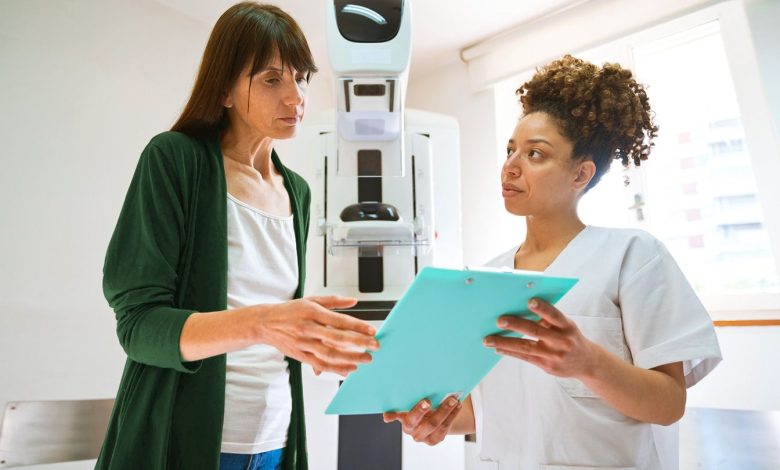8 Things You Should Know About Your Next Mammogram

[ad_1]
With current recommendations stressing the importance of getting an annual mammogram once you’re 40, there’s never been a better time to get prepped for this low-dose X-ray of the breasts. We asked Colleen M. Madden, MD, the division chief of breast imaging at Indiana University Health–IU School of Medicine in Indianapolis, to sketch out eight things you need to know about this screening test that takes about 20 minutes.
1. Skip the Deodorant
It’s the aluminum (and other particles) in deodorants, antiperspirants, and lotions that can appear as white spots on the images, so avoid applying anything under your arms or on your breasts themselves. “Since aluminum is a metal, it will show on a mammogram as an artifact and that can mimic breast cancer or raise an alarm when it’s read,” Dr. Madden explains.
2. Dress for the Test
Instead of wearing a dress or one-piece jumpsuit, opt instead for separates on mammogram day. “It’s better to wear a skirt or shorts and a top,” she says. “This way you can leave your skirt or shorts on and only have to remove your top and bra before you put on your robe.” Tip: Flats or sandals are a better option for footwear than heels, as you’ll take the test while standing and you will be asked to lean in different directions as your breasts are positioned.
3. Schedule Your Test After Your Period
If you tend to have tender breasts one week before and the week during your period, don’t schedule your mammogram at this time. “We compress the breasts as part of the exam, so you wouldn’t want to have your mammogram if your breasts are tender or if you experience breast pain during those days,” Madden advises. Tip: Consider booking your mammogram one week after your period. You can also take over-the-counter acetaminophen (Tylenol) an hour before your mammogram if you experience breast pain while you’re being screened. Just be sure to speak with your healthcare provider before taking a new medication.
4. Stow Your Accessories
Take off any jewelry (especially long necklaces) before your mammogram. Most health facilities have lockers where you can keep your jewelry during your mammogram. “Most of the time, the technologists can push a necklace out of the way, but a long necklace might have to be removed,” she says. “In addition, you may need to remove your eyeglasses as they may interfere with getting clear X-ray images.”
5. Be Wise About Caffeine
If you drink a lot of caffeinated beverages, this can prompt increased breast pain and tenderness, but caffeine is a “Pandora’s box” when it comes to mammograms, according to Madden. “If your breasts are tender due to your caffeine consumption, you would need to stop drinking coffee way before the morning of your appointment,” she says. Tip: Cutting down on caffeinated drinks (and chocolate) four or five days before your appointment might help reduce tenderness.
6. Bring Prior Mammogram Images
If you’re making your first appointment at a new imaging center, bring any images you’ve had in the past so the radiologist on-site can compare them. If you don’t have them on hand, ask for help. “We have staffers we call film loan assistants who will ask you to sign a consent and we can send that to the prior facility,” Madden says. “They’ll forward those images to us via the cloud or in the mail.”
7. Discuss Any Physical Limitations
If your neck gets tight during a mammogram, or you can’t turn your head, or you’ve had a stroke and can’t raise your arm, tell the technologist. “They can tailor the mammogram to how you’re feeling,” explains. “We don’t like to use less compression, but we’d rather you come in and get your mammogram than skipping it. We want to get the best possible images, but we don’t want to cause harm or additional discomfort.” The same goes for people with mobility issues (e.g., wheelchair users) — make sure to call ahead to see about accommodations.
8. Ask for 3D Imagery
Every mammogram consists of two pictures of each breast — two on the right, two on the left — so four images total. However, make sure your imaging facility only uses digital breast tomosynthesis (aka 3D mammography) instead of 2D. “Most sites in the country have converted to 3D,” says Madden. “With 3D images, it’s the same four images but, within each, there are about 20 to 30 additional slices for us to review so we can see deeper portions of the breast.”
[ad_2]




